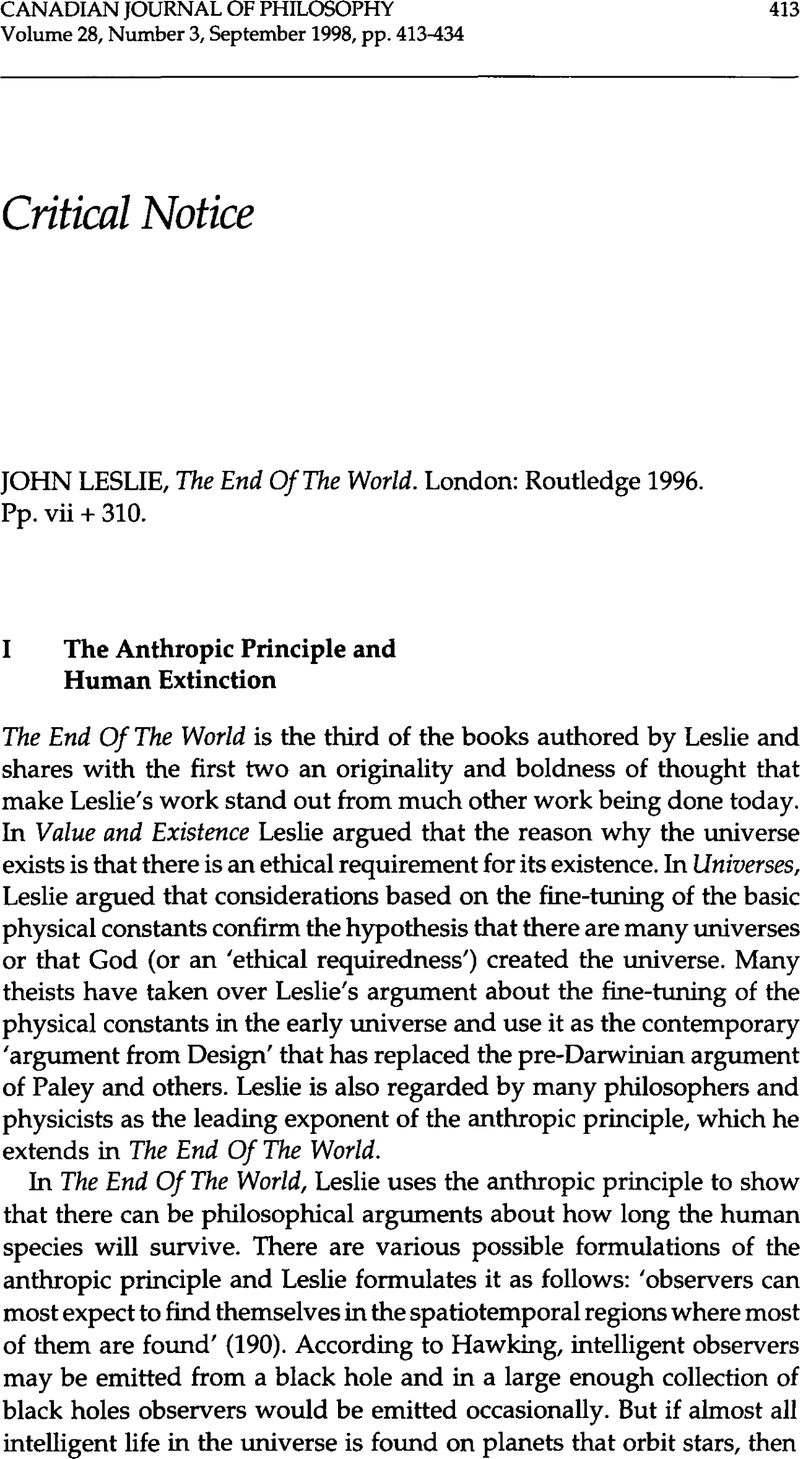No CrossRef data available.
Article contents
John Leslie, The End Of The World. London: Routledge 1996. Pp. vii + 310.
Published online by Cambridge University Press: 01 January 2020
Abstract

- Type
- Critical Notice
- Information
- Copyright
- Copyright © The Authors 1998
References
1 This is the estimate Leslie gives in his book. In a private communication, he explained that his estimation of doom prior to taking into account the doomsday argument is 5%, and 30% is his estimation that takes into account Doomsday reasoning. The reason it is not higher than 30%, he says, is that he believes the universe may well be indeterminist to a significant extent and that this lowers his estimate of doom to 30%.
2 Sagan, Carl Cosmos (New York: Random House 1980), 322Google Scholar
3 Scientific American (October 1987), 26
4 Sagan,322
5 See Turco, R. et. al., ‘Nuclear Winter’, Science 222 (December 23, 1983), 1283–92CrossRefGoogle ScholarPubMed, and Turco, R. et. al. ‘The Climatic Effects of Nuclear War’, Scientific American (August 1984)CrossRefGoogle Scholar.
6 Sagan, 321
7 Sagan,322
8 See ‘Ten Years of the Chemoyble Era’, by Yuri Shcherbak, Scientific American (April 1996), 45
9 Yuri, 45
10 Yuri, 46
11 Turo, R. et al. ‘The Climatic Effects of Nuclear War’, Scientific American (August 1984)Google Scholar.
12 Blair, B. and Kendall, H. ‘Accidental Nuclear War’, Scientific American (December 1990)CrossRefGoogle Scholar.
13 Seaton, Albert The Battle for Moscow (New York: A Jove Book 1983), 291Google Scholar
14 O'Brien, S. and Dean, M. ‘In Search of AIDS-Resistance Genes’, Scientific American (September 1997), 44CrossRefGoogle Scholar
15 See Avers, Charlotte Process and Pattern in Evolution (New York: Oxford University Press 1989).Google Scholar
16 In response to this criticism, Leslie reports (private communication) that Reeve, S. Adams, J. and Davison, J. wrote in World Press Review (September 1996), 37Google Scholar, that ‘The most extreme forecasts are that 45,000 mainframe computers will crash, paralyzing whole societies. An American study suggests that preventing a global millennium meltdown may cost around $600 billion … [In the US] the Defense Department has even warned of a potentially “catastrophic” outcome in which the country would be unable to respond to military threats and some weapon systems could run out of control.’
17 Levin, Harold The Earth Through Time, fifth edition (Saunders College Publishing 1996), 570Google Scholar
18 This ‘consistent histories’ interpretation of quantum mechanics is the interpretation favored by many or most of the physicists currently writing on the problem of interpreting quantum mechanics, including almost all those working in the area of quantum cosmology. This interpretation is ignored or rejected by most or virtually all philosophers of quantum mechanics. (Conversely, the various interpretations of quantum mechanics developed by philosophers in the 1980s and 1990s are typically ignored by physicists.) One of the many consequences of the divergent paths taken by the leading quantum physicists and the leading quantum philosophers is that almost no philosophical attention is paid to the most recent developments in quantum gravity cosmology, such as the ‘no boundary’ and ‘tunnelling’ wave functions of the universe; their authors (Hartle, Hawking, Linde, Vilenkin, Halliwell, etc.,) presuppose the ‘consistent histories’ interpretation. Exceptions to this trend are the philosophers Craig Callender, Robert Weingard, William Lane Craig, Robert Deltete and others, although none of these philosophers accept the ‘consistent histories’ interpretation. References to the relevant writings can be found in Craig, William Lane and Smith, Quentin Theism, Atheism and Big Bang Cosmology (Oxford: Clarendon Press 1993)Google Scholar, Smith, Quentin ‘The Ontological Interpretation of the Wave Function of the Universe’, The Monist 80 (January 1997) 160–85CrossRefGoogle Scholar, and Smith, Quentin ‘Quantum Cosmology's Implication of Atheism’, Analysis (October 1997)CrossRefGoogle Scholar. In these writings, I explicitly or tacitly assumed the ‘consistent histories’ interpretation.
19 Levin, The Earth Through Time, 558Google Scholar
20 Dieks, D. ‘Doomsday-or: The Dangers of Statistics’, The Philosophical Quarterly 42 (1992), 78–84CrossRefGoogle Scholar
21 Eckhardt, William ‘Probability Theory and the Doomsday Argument’, Mind 102 (1993), 483–8CrossRefGoogle Scholar; ‘A Shooting-Room View of Doomsday', Journal of Philosophy 94 (1997)
22 Eckhardt, William ‘A Shooting-Room View of Doomsday’, Journal of Philosophy 94 (1997), 244CrossRefGoogle Scholar
23 Flew, Anthony Philosophy 72 (January 1997), 158–60CrossRefGoogle Scholar. Flew writes: ‘This Doomsday Argument has been so often and so fiercely challenged that Leslie devotes the greater part of two whole chapters to its defence. Since it seems to me, for whatever that it is worth, to be manifestly valid I will say no more about it here’ (159).
24 I wish to thank Arthur Falk for discussions of the Doomsday argument and John Leslie for providing many helpful criticisms of an earlier draft. I should also like to thank the book review editor for this journal for some helpful suggestions.


